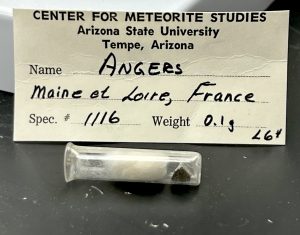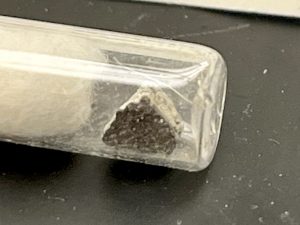Angers
Angers is an L6 chondrite. This daytime meteorite fall occurred June 3rd of 1822, and the stones landed in a garden in the city of Angers, France, located approximately 300 km south-west of Paris.
Following, is an account of the event as later related in the Edinburgh Advertiser newspaper (Scotland):
Tuesday, January 14, 1823
ACCOUNT OF THE FALL OF AN AEROLITE
A heat prevailed in Anjou, and probably in the rest of France, during the whole most of May 1822, such as is seldom felt except in July and August, and without being attended with the showers which, in the west of France fall pretty regular at this period. The air was all the while calm, and the sky nearly cloudless. On the 3d of June last, the same clear weather prevailed. At a quarter past eight in the evening of this day there was seen, from several remote places, (at London, for example, and at Angers, sixteen leagues from each other,) a globe of bright light in a southern direction from Angers, lasting for several seconds, and dispersing in luminous waves. This light was followed by a very loud detonation, succeeded by a number of sharp reports, like the vollies of masquerty [sic], lasting for five or six seconds, which attracted the attention of many persons, who had not happened to observe the luminous appearance. This was folled [sic] by a fall of stones, proceeding from the same direction, one of which, weighing thirty ounces, fell in a garden of the Faubourg Gaven, at Angers, seven feet distant from a women watering the plants. We have every reason to believe that many other similar stones must have fallen at the same time around Angers, but no certain fact of the kind has, as yet, come to my knowledge. The above mentioned stone is an irregular angular fragment, showing that it must have been a splinter of a large mass. It is covered with a blackish brown crust, of a uniform thickness, which must be attributed to the action of fire; as there is a bubble on one part of the surface, as if in this spot a greater intensity of heat had began to melt it. The inner part of this aerolite has the same appearance and the texture as that which fell at L’Aigle several years ago, a fragment of which is preserved in the Museum of Natural History at Angers. When the meteor was first observed, many persons affirm that they saw the stone, which has been preserved, falling down in an oblique direction, like a ball from a poece [sic] of ordnance. As this fragment happened to fall on a hard garden walk, it only made an indentation half and inch deep, attended with the dispersion of the earth around it, so as to alarm, grievously, the person near whom it fell. Though it was picked up almost immediately after its fall, it was not sensibly warmer than the atmosphere.
– Annales de Chimie et de Physique.

